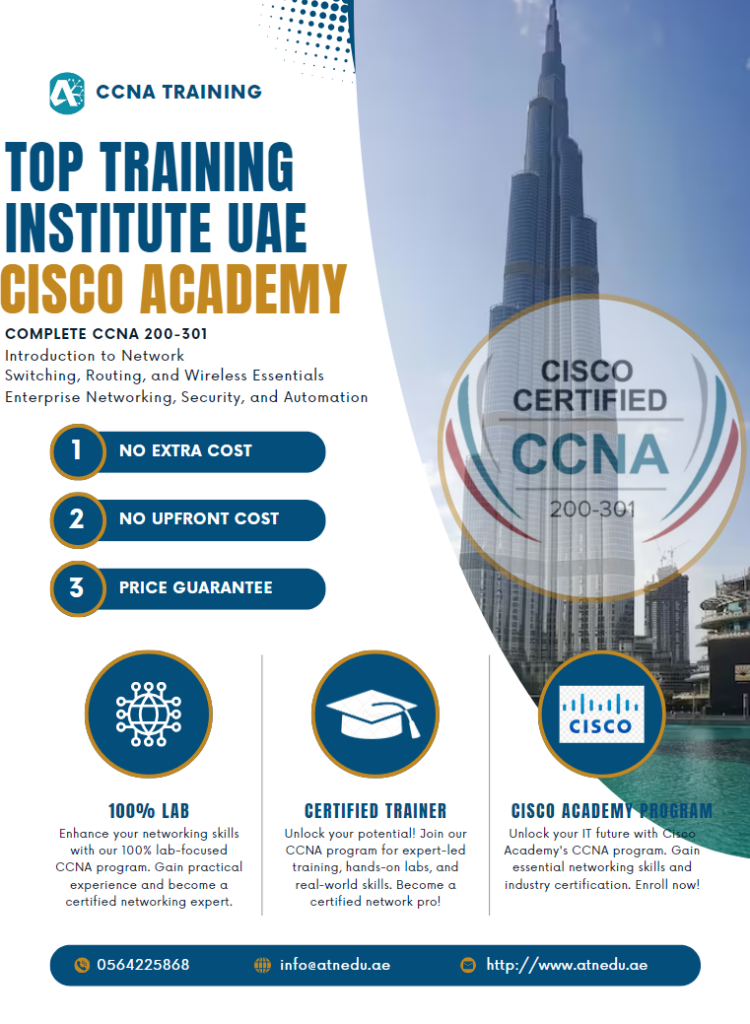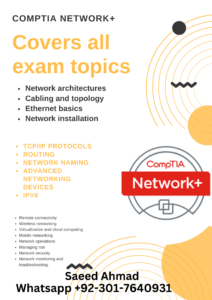Online CCNA Training Cost in USA
By ccna200-301Comments Off on Online CCNA Training Cost in USA
CCNA Instructor-led Training Cost in USA
Course Details
- Estimated Length: 30 Hours
-
Price: $1,100.00
To enroll, please call: +92-301-7640931
Introduction to Networks (ITN)
- Module: Networking Today –
Objective: Explain the advances in modern network technologies. - Module: Basic Switch and Device Configuration –
Objective: Implement initial settings including passwords, IP addressing, and default gateway parameters on a network switch and end devices. - Module: Protocols and Models –
Objective: Explain how network protocols enable devices to access local and remote network resources. - Module: Physical Layer –
Objective: Explain how physical layer protocols, services, and network media support communications across data networks. - Module: Number Systems –
Objective: Calculate numbers between decimal and binary systems. - Module: Data Link Layer –
Objective: Explain how media access control in the data link layer supports communication across networks. - Module: Ethernet Switching –
Objective: Explain how Ethernet operates in a switched network. - Module: Network Layer –
Objective: Explain how routers use network layer protocols and services to enable end-to-end connectivity. - Module: Address Resolution –
Objective: Explain how ARP and ND enable communication on a local area network. - Module: Basic Router Configuration –
Objective: Implement initial settings on a router and end devices. - Module: IPv4 Addressing –
Objective: Calculate an IPv4 subnetting scheme to efficiently segment your network. - Module: IPv6 Addressing –
Objective: Implement an IPv6 addressing scheme. - Module: ICMP –
Objective: Use various tools to test network connectivity. - Module: Transport Layer –
Objective: Compare the operations of transport layer protocols in supporting end-to-end communication. - Module: Application Layer –
Objective: Explain the operation of application layer protocols in providing support to end-user applications. - Module: Network Security Fundamentals –
Objective: Configure switches and routers with device hardening features to enhance security. - Module: Build a Small Network –
Objective: Implement a network design for a small network to include a router, a switch, and end devices.
Switching, Routing, and Wireless Essentials (SRWE)
- Module: Basic Device Configuration –
Objective: Configure devices by using security best practices. - Module: Switching Concepts –
Objective: Explain how Layer 2 switches forward data. - Module: VLANs Implement –
Objective: VLANs and trunking in a switched network. - Module: Inter-VLAN Routing –
Objective: Troubleshoot inter-VLAN routing on Layer 3 devices. - Module: STP –
Objective: Explain how STP enables redundancy in a Layer 2 network. - Module: EtherChannel –
Objective: Troubleshoot EtherChannel on switched links. - Module: DHCPv4 –
Objective: Implement DHCPv4 to operate across multiple LANs. - Module: SLAAC and DHCPv6 Concepts –
Objective: Explain the operation of dynamic address allocation in IPv6 networks. - Module: FHRP Concepts –
Objective: Explain how FHRPs provide default gateway services in a redundant network. - Module: LAN Security Concepts –
Objective: Explain how vulnerabilities compromise LAN security. - Module: Switch Security Configuration –
Objective: Configure switch security to mitigate LAN attacks. - Module: WLAN Concepts –
Objective: Explain how WLANs enable network connectivity. - Module: WLAN Configuration –
Objective: Implement a WLAN using a wireless router and WLC. - Module: Routing Concepts –
Objective: Explain how routers use information in packets to make forwarding decisions. - Module: IP Static Routing –
Objective: Configure IPv4 and IPv6 floating static routes. - Module: Troubleshoot Static and Default Routes –
Objective: Explain how to troubleshoot static and default route configurations.
Ent. Networking, Security, & Automation (ENSA)
- Module: Single-Area OSPFv2 Concepts –
Objective: Explain how single-area OSPF operates in both point-to-point and broadcast multiaccess networks. - Module: Single-Area OSPFv2 Configuration –
Objective: Implement single-area OSPFv2 in both point-to-point and broadcast multiaccess networks. - Module: Network Security Concepts –
Objective: Explain how vulnerabilities, threats, and exploits can be mitigated to enhance network security. - Module: ACL Concepts –
Objective: Explain how ACLs are used as part of a network security policy. - Module: ACLs for IPv4 Configuration –
Objective: Implement IPv4 ACLs to filter traffic and secure administrative access. - Module: NAT for IPv4 –
Objective: Implement NAT services on the edge router to provide IPv4 address scalability. - Module: WAN Concepts –
Objective: Explain how WAN access technologies can be used to satisfy business requirements. - Module: VPN and IPsec Concepts –
Objective: Explain how VPNs and IPsec are used to secure site-to-site and remote access connectivity. - Module: QoS Concepts –
Objective: Explain how networking devices implement QoS. - Module: Network Management –
Objective: Implement network management protocols to monitor the network. - Module: Network Design –
Objective: Explain the characteristics of scalable network architectures. - Module: Network Troubleshooting –
Objective: Troubleshoot enterprise networks. - Module: Network Virtualization –
Objective: Explain the purpose and characteristics of network virtualization. - Module: Network Automation –
Objective: Explain how network automation is enabled through RESTful APIs and configuration management tools.
For more information or to enroll, please contact us at:
Whatsapp: +92-301-7640931









